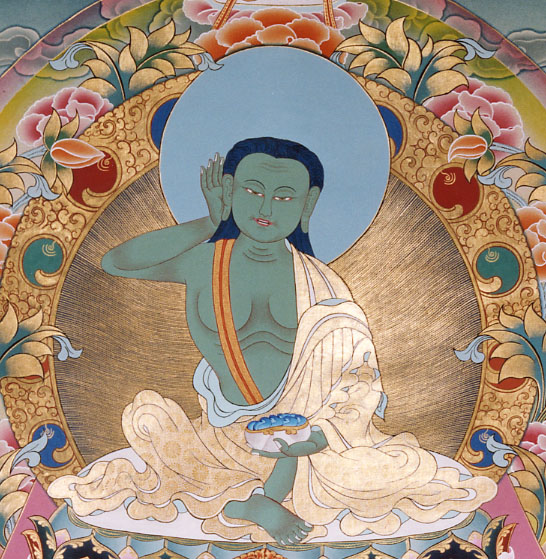DAVID RATHBUN
SOUTH HIGH SCHOOL, MINNEAPOLIS
WHERE IS MILAREPA IN WORLD LITERATURE?
HOME
Stone
sculpture of Milarepa from the Collection of Shelley and Donald Rubin.
Item no. 700067 in the Rubin Museum of Art in New York.
In this sculpture Milarepa appears as the idealized ascetic with his ribcage protruding, shrunken neck, little clothing, and holding a begging bowl in his left hand.
In accordance with my ascetic practice, I will seek food as do the mice and birds. So I have no need of a field. My abode will be an empty cave. Therefore I do not need a house. Even if one were Master of the Universe, at the moment of death one must give up everything. If one renounces everything now, one will be happy here and hereafter. That is why, quite the opposite of what others do, I have now given up everything and everybody. (Life, 111)
Sustaining myself with nettles, I continued my meditation. Because I had no clothes on my body and no other nourishment whatever, my body, covered with grayish hair, became like a skeleton and my skin turned the color of nettles (Life, 118).
That's why in some representations of Milarepa his skin is a green or greenish-blue color. See the image at the bottom of this page....
However, Milarepa did have his moments when he went off his diet: "Zessay [his former betrothed] came to see me with Peta [his sister], bringing me meat, butter, tsampa, and a great deal of beer." (Life, 125)
In my world literature class, The Odyssey is a central text. Milarepa as a cultural hero, wanderer, an epic hero who struggles against himself and various obstacles, who interacts with gods and goddesses, who finally achieves his goal, could be nicely compared and contrasted with Homer's greatest epic hero.
Perhaps the most poignant scenes in The Odyssey and The Life of Milarepa have to with their respective mothers. While traveling away from home, both Odysseus and Milarepa long to see their mothers. Unfortunately, neither one is destined to be reunited with his mother. In each case the poetry surrounding that loss is vivid and moving.
R.A. Stein quotes Odysseus' (Ulysses') words in The Inferno for an epigraph to his book Tibetan Civilization. The lines are also appropriate for Milarepa's life:
Consider ye the seed from which he sprang:
Ye were not made to live like unto brutes,
But for pursuit of virtue and of knowledge
Stein also makes the case for Milarepa as epic hero while explaining Milarepa's gesture in the above image:
Mila Repa, Drukpa Kunlek and other poet saints of the Kagyu-pa order are depicted singing and holding their right hand to their ear. The same gesture is characteristic of the epic hero, when identified with the bard or when receiving revelations from the gods. The gesture expresses both religious and poetic inspiration in the saints' case, too, at the same time symbolizing their receipt of the oral transmissions.
The extended metaphors and similes used by Milarepa are similar poetic devices used by Homer. In one of his songs Milarepa constructs an metaphor that equates a farmer cultivating a field with himself developing his mind for Enlightenment.
Next
image: Ground mineral pigment on cotton, 19th c. Buryet Historical Museum.
Item no. 74209 in the Rubin Museum of Art in New York.
Here we see Milarepa in his cave with two other figures in the foreground, a hunter and a deer. This scene relates to the story of Milarepa encountering a hunter stalking a deer, and Milarepa's compassion for the deer saves the animal's life. At the same time, despite initial hostility, the hunter becomes a disciple of Milarepa following the saint's invitation:
The snow, the rocks, and the clay mountains--
These three are where Mila meditates;
If you they satisfy,
You may come with me.
The deer, the argali, and the antelope--
These three are Mila's cattle;
If you they satisfy,
You may come with me.
from "The Huntsman and the Deer"
The Hundred Thousand Songs of Milarepa (Volume One)
Trans. Carma C.C. Chang (Shambhala, 1989)
Below we see Milarepa with his greenish-blue skin. The red and gold band running from his right shoulder down to his waist is called the "cord of meditation" (gom-thak). He looks healthier here than in the above sculpture, but we know he's been living on a diet of nettles due to the color of his skin. He's also holding his begging bowl. He willingly accepts food from those who pass by his cave. Hunters often leave him some leftover meat. For a while his sister brings food to his cave. By the way, he doesn't eat raw nettles. He cooks them in a pot.
Milarepa's unique gesture, which immediately sets him apart from other images of mystics and yogis, is his right hand raised to his ear, likely a reference to his life amidst nature, listening to its message, as well as a reference to Tantric practices, where the instructions of the guru are transmitted orally. (The Art of Tibet by Robert E. Fisher)
My body, inside and outside,
has become like a nettle,
It will never lose its greenness.
(The Life of Milarepa, 124)

This site was created by DAVID RATHBUN at the NEH Summer Institute "Cultures and Religions of the Himalayan Region," held at the College of the Holy Cross, Summer 2004